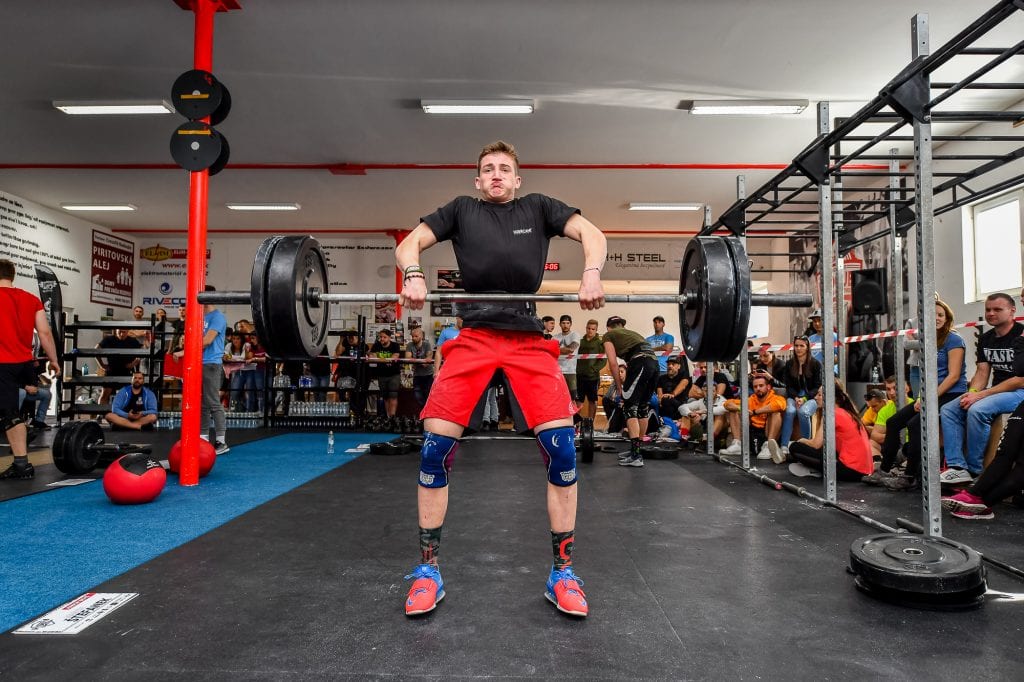Try adding these exercises into your training if you want to speed up your fat loss.
Why is HIIT an Effective Exercise Method for Burning Calories?
HIIT, which stands for High-Intensity Interval Training, is an effective exercise method for burning calories due to several key factors:
Increased calorie expenditure: HIIT involves short bursts of intense exercise followed by periods of rest or lower-intensity exercise. This high-intensity nature leads to a significant increase in calorie expenditure during the workout itself. The intense efforts push your body to work harder and burn more calories compared to traditional steady-state exercises.
EPOC effect: EPOC stands for Excess Post-Exercise Oxygen Consumption. HIIT workouts create an oxygen debt in your body, which means that after the workout, your body needs to replenish its oxygen levels, restore metabolic balance, and repair muscle tissue. This process requires energy, and studies have shown that HIIT can elevate your metabolic rate and increase calorie burn for hours after the workout, even when you’re at rest. This phenomenon contributes to additional calorie expenditure compared to lower-intensity workouts.
Muscle preservation and metabolic benefits: HIIT not only burns calories during the exercise session but also helps preserve muscle mass. The high-intensity intervals and resistance exercises in HIIT stimulate muscle fibres, helping to maintain and build lean muscle. Since muscle is more metabolically active than fat, having more muscle mass can boost your overall metabolism, leading to increased calorie burn even when you’re not exercising.
Time efficiency: HIIT workouts are typically shorter in duration compared to steady-state cardio exercises. A typical HIIT session can range from 10 to 30 minutes, making it a time-efficient option for those with busy schedules. Despite the shorter duration, the intense nature of HIIT allows you to burn a significant number of calories in a shorter amount of time compared to longer, moderate-intensity workouts.
It’s important to note that while HIIT can be an effective calorie-burning exercise method, it may not be suitable for everyone. Individuals with certain health conditions or who are new to exercise should consult with a healthcare professional or fitness expert before starting a HIIT program. Additionally, it’s essential to prioritize proper form, warm-up, and gradual progression to avoid injury and maximize the benefits of HIIT training.
10 Exercises
1. Medicine Ball Slam
2. Cable Woodchopper
3. Weighted Burpee
4. Kettlebell Swings
5. Kettlebell Long Cycle
6. Battle Rope
7. Prowler
8. Mountain Climber
9. Hammer Swing
10. Turkish Get-Up
Video – How to Program the Exercises into HIIT Format Workouts
What are the Benefits of Lower Body Fat Levels?
Lowering body fat levels can offer several benefits for overall health and well-being. Here are some of the benefits associated with achieving and maintaining lower body fat levels:
Improved cardiovascular health: Excess body fat, particularly around the abdomen, is linked to an increased risk of cardiovascular diseases such as heart disease and high blood pressure. By reducing body fat levels, you can lower the strain on your heart, improve blood flow, and reduce the risk of cardiovascular problems.
Reduced risk of chronic diseases: Lower body fat levels are associated with a decreased risk of various chronic conditions such as type 2 diabetes, certain types of cancer (e.g., breast, colorectal), and metabolic syndrome. Maintaining a healthy body fat percentage can positively impact insulin sensitivity, blood sugar regulation, and overall metabolic health.
 Source: Courtesy of CrossFit Inc.
Source: Courtesy of CrossFit Inc.Enhanced physical performance: Carrying excess body fat can impair physical performance, as it adds extra weight that the body needs to move. By reducing body fat levels, individuals often experience improved agility, speed, endurance, and overall athletic performance. This can be particularly beneficial for sports, recreational activities, and daily functional tasks.
Improved joint health: Excessive body fat places extra stress on the joints, particularly in weight-bearing areas such as the knees and hips. This can contribute to joint pain, inflammation, and an increased risk of conditions like osteoarthritis. Lowering body fat levels can alleviate joint stress, improve joint function, and reduce the likelihood of joint-related issues.
Enhanced body composition and aesthetics: Lower body fat levels are typically associated with a leaner and more defined physique. By reducing body fat and increasing muscle mass through exercise and proper nutrition, you can achieve a more toned appearance and improve body composition. This can boost self-confidence and improve body image.
Improved hormonal balance: Excessive body fat can disrupt hormonal balance, leading to imbalances in hormones such as insulin, estrogen, testosterone, and leptin. Lowering body fat levels can help restore hormonal balance, leading to improved overall health, energy levels, and better regulation of appetite and metabolism.
It’s important to note that everyone’s ideal body fat levels may vary depending on factors such as age, gender, genetics, and individual goals. It’s always recommended to work with a healthcare professional or a registered dietitian to determine a healthy and sustainable body fat percentage for your specific needs.
Medicine Ball Slam Exercise
The medicine ball slam exercise offers several advantages for individuals looking to improve their fitness and overall strength. Here are some of the advantages of incorporating medicine ball slams into your workout routine:
Full-body workout: Medicine ball slams engage multiple muscle groups throughout the body, making it an effective full-body exercise. The explosive movement involved in the exercise activates the muscles in the upper body, including the shoulders, chest, arms, and core. Additionally, the lower body muscles, such as the glutes, quads, and hamstrings, are also engaged during the slamming and squatting motions.
Cardiovascular benefits: Medicine ball slams are a high-intensity exercise that elevates heart rate and provides cardiovascular benefits. The rapid and forceful movements involved in slamming the ball repeatedly increase heart rate and contribute to improved cardiovascular endurance. This makes it an effective exercise for boosting aerobic capacity and burning calories.
Power and explosiveness: The medicine ball slam exercise is a powerful explosive movement that requires generating force from the lower body and transferring it through the core to the upper body. This movement pattern helps develop power and explosiveness, which can be beneficial for sports performance, athletic activities, and activities that require quick and forceful movements.
Core strength and stability: Medicine ball slams heavily engage the muscles of the core, including the rectus abdominis, obliques, and deep stabilizing muscles. The explosive nature of the exercise requires strong core activation to generate and control the force. Regularly incorporating medicine ball slams can help improve core strength, stability, and overall functional movement patterns.
Stress release and mental focus: Medicine ball slams provide an opportunity for releasing stress and pent-up energy. The forceful slamming motion can serve as a physical outlet and help improve mental focus by requiring concentration and coordination. It can be an effective exercise to release tension and promote mental clarity.
Versatility and accessibility: Medicine ball slams can be performed with minimal equipment—a medicine ball—and in various settings, such as at the gym, at home, or outdoors. The exercise is suitable for individuals of different fitness levels, and the intensity can be adjusted by selecting a suitable weight of the medicine ball and modifying the speed and force of the slams.
As with any exercise, it’s important to maintain proper form, start with an appropriate weight and progression, and listen to your body’s limits. If you have any pre-existing medical conditions or concerns, it’s advisable to consult with a healthcare or fitness professional before incorporating medicine ball slams into your exercise routine.
Cable Woodchop Exercise
The cable woodchop exercise is a compound movement that targets multiple muscle groups and offers several benefits for strengthening the body. Here’s how the cable woodchop exercise can contribute to improved strength:
Core strength: The cable woodchop primarily targets the muscles of the core, including the rectus abdominis, obliques, and transverse abdominis. These muscles work in a coordinated manner to generate and control the twisting and rotational movement involved in the exercise. As a result, regular performance of cable woodchops can lead to improved core strength, stability, and enhanced functional movement patterns.
Rotational strength: The rotational aspect of the cable woodchop exercise helps develop strength in the muscles responsible for rotation, including the obliques, internal and external obliques, and the muscles of the lower back. These muscles are vital for activities that involve twisting and turning motions, such as sports, daily activities, and functional movements.

Upper body strength: The cable woodchop exercise also engages the muscles of the upper body, including the shoulders, back, and arms. During the downward phase of the woodchop, the muscles in the back and shoulders work to control and decelerate the movement, providing an eccentric contraction. During the upward phase, these muscles generate force to pull the cable back up. As a result, the exercise helps improve upper body strength and muscle endurance.
Leg and hip strength: The lower body muscles, including the glutes, quadriceps, hamstrings, and hip muscles, are engaged during the cable woodchop exercise. The lower body provides a stable base and generates power as you initiate the movement by twisting and rotating from the hips. Strengthening the lower body muscles contributes to overall stability, balance, and functional movement.
Improved coordination and balance: The cable woodchop exercise requires coordination between the upper and lower body, particularly in terms of timing and sequencing the movements. This exercise can help improve neuromuscular coordination and balance, as well as reinforce proper movement patterns.
Functional strength and performance: The cable woodchop exercise mimics rotational movements often encountered in daily life, sports, and activities. By training these specific movement patterns, the exercise can enhance functional strength and performance, making everyday tasks and athletic activities easier and more efficient.
When performing the cable woodchop exercise, it’s important to maintain proper form, start with an appropriate weight, and progress gradually. If you have any pre-existing medical conditions or concerns, it’s advisable to consult with a healthcare or fitness professional to ensure the exercise is suitable for you and to receive guidance on proper execution.
Burpee
The burpee is a dynamic and intense exercise that can provide significant cardiovascular benefits. Here’s how the burpee enhances the cardiovascular system:
Increased heart rate: The burpee is a high-intensity exercise that involves explosive movements, including a squat, plank, push-up, and jump. These rapid and demanding actions require a significant amount of effort and energy. As a result, the heart rate increases rapidly to supply oxygen and nutrients to the working muscles. Sustained elevation of the heart rate during a burpee workout helps improve cardiovascular endurance and strengthens the heart.
Aerobic exercise: Burpees are primarily an aerobic exercise, meaning they use oxygen to meet the energy demands of the body. Performing burpees repeatedly for a prolonged duration challenges the cardiovascular system, increasing the oxygen uptake and delivery to the muscles. This helps improve the efficiency of the heart and lungs, enhancing aerobic capacity and endurance.
Calorie burning: Burpees are a full-body exercise that engages multiple large muscle groups simultaneously. This combination of strength and cardio exercise leads to a high caloric expenditure. The more calories you burn during a workout, the greater the cardiovascular demand. Regularly incorporating burpees into your routine can contribute to weight management and overall cardiovascular health.
 Source: Courtesy of CrossFit Inc.
Source: Courtesy of CrossFit Inc.Interval training benefits: Burpees can be incorporated into high-intensity interval training (HIIT) workouts, which are known for their cardiovascular benefits. HIIT alternates between short bursts of intense exercise, like burpees, and periods of rest or lower-intensity exercise. This interval format challenges the cardiovascular system by repeatedly elevating and recovering the heart rate, promoting cardiovascular adaptations and improved aerobic fitness.
Metabolic boost: The intense nature of the burpee exercise elicits an elevated metabolic response. This means that even after completing a set of burpees, your body continues to burn calories at an elevated rate during the recovery period. This post-exercise calorie burn, known as excess post-exercise oxygen consumption (EPOC), contributes to additional cardiovascular and metabolic benefits.
Improved circulation: Burpees involve movements that require blood to flow against gravity, such as when transitioning from a push-up position to a standing jump. This aids in the improvement of circulation and helps the body efficiently transport oxygen and nutrients to the muscles. Enhanced circulation supports overall cardiovascular health and function.
It’s worth noting that burpees are a demanding exercise, and individuals should start at an appropriate fitness level and progress gradually. If you have any pre-existing medical conditions or concerns, it’s advisable to consult with a healthcare or fitness professional to determine if burpees are suitable for you and to receive guidance on proper form and execution.
Kettlebell Swings
Kettlebell swings primarily target the muscles of the posterior chain, which includes the muscles on the backside of the body. Here are the key muscles worked during kettlebell swings:
- Glutes: The gluteus maximus, the largest muscle in the buttocks, is the primary muscle activated during kettlebell swings. It is responsible for hip extension, which occurs during the explosive hip thrust at the top of the swing. Kettlebell swings can help strengthen and tone the glutes.
- Hamstrings: The muscles at the back of the thighs, known as the hamstrings, are heavily engaged during kettlebell swings. They work dynamically to extend the hips and stabilize the knees during the swinging motion. Strengthening the hamstrings can improve overall lower body strength and stability.
- Core muscles: Kettlebell swings are effective for strengthening the core muscles, including the rectus abdominis (six-pack muscles), obliques (side abdominal muscles), and the deep stabilizing muscles of the core. These muscles engage to stabilize the torso and maintain proper posture throughout the swing. A strong core is essential for generating power and transferring force efficiently.
- Lower back muscles: The erector spinae muscles, located along the spine, play a vital role in kettlebell swings. They provide stability to the lower back and help maintain an upright posture during the movement. However, it’s important to engage the core properly to avoid excessive strain on the lower back.
- Quadriceps: Although the emphasis of kettlebell swings is on the posterior chain, the muscles at the front of the thighs, known as the quadriceps, also play a supportive role. They assist in extending the knees during the upward phase of the swing.
- Hip muscles: The hip adductors (inner thigh muscles) and the hip abductors (outer hip muscles) are also activated to some degree during kettlebell swings. These muscles contribute to hip stability and help maintain proper alignment throughout the movement.
- Additionally, kettlebell swings require the involvement of stabilizer muscles, such as the muscles of the shoulder girdle, upper back, and grip muscles. These muscles assist in maintaining control of the kettlebell and proper posture during the exercise.
It’s important to perform kettlebell swings with proper form and technique to maximize muscle activation and minimize the risk of injury.
Mountain Climber Exercise
Yes, the mountain climber is considered an effective abs exercise. While it primarily targets the core muscles, it also engages several other muscle groups, making it a compound exercise that provides multiple benefits.
Here’s how the mountain climber targets and strengthens the abs:
Rectus abdominis: The rectus abdominis, commonly known as the “six-pack” muscles, is the main muscle targeted during mountain climbers. This muscle group runs vertically along the front of the abdomen and is responsible for flexing the trunk. As you bring your knees toward your chest in a mountain climber, you engage the rectus abdominis, which helps strengthen and tone these muscles.
Obliques: The obliques, located on the sides of the abdomen, are also activated during mountain climbers. These muscles are responsible for rotation and lateral flexion of the trunk. As you bring your knees diagonally towards the opposite elbow during the exercise, the obliques work to stabilize and rotate the torso, helping to improve overall core strength and stability.
Transverse abdominis: The transverse abdominis is a deep abdominal muscle that wraps around the sides and front of the abdomen, acting as a corset to provide stability and support to the spine. Mountain climbers engage the transverse abdominis to help stabilize the core and maintain proper alignment during the exercise.
Hip flexors: The hip flexor muscles, including the iliopsoas and rectus femoris, are also engaged during mountain climbers. These muscles connect the hip and thigh and assist in raising the knees toward the chest. Engaging the hip flexors in the mountain climber exercise helps improve their strength and flexibility.
Upper body muscles: In addition to targeting the abs, mountain climbers engage the muscles of the upper body, including the shoulders, chest, and arms. The muscles in the shoulders and arms work isometrically to stabilize the upper body and maintain the plank position while performing the exercise.
Furthermore, mountain climbers are a dynamic exercise that raises the heart rate, providing cardiovascular benefits and contributing to calorie burning. This exercise also enhances overall core stability, improves coordination, and challenges the muscles of the lower body, including the quadriceps, hamstrings, and glutes.
To maximize the effectiveness of mountain climbers, it’s important to maintain proper form, including a neutral spine, engaged core, and controlled movements. Gradually increase the intensity and duration as your strength and endurance improve.
Turkish Get Up
The Turkish get-up is a highly effective and complex exercise that targets multiple muscle groups throughout the body. Here are the key muscles that the Turkish get-up strengthens:
Core muscles: The Turkish get-up heavily engages the muscles of the core, including the rectus abdominis (six-pack muscles), obliques (side abdominal muscles), and transverse abdominis (deep abdominal stabilizers). These muscles work together to stabilize the torso and maintain proper alignment during the movement.
Shoulders: The Turkish get-up requires a significant amount of shoulder stability and strength. The exercise engages the deltoids (shoulder muscles), particularly the anterior (front) and medial (side) heads, as they work to stabilize and control the weight overhead throughout the movement.
Upper back and scapular stabilizers: The muscles of the upper back, including the trapezius, rhomboids, and serratus anterior, are activated during the Turkish get-up. These muscles assist in maintaining proper scapular (shoulder blade) position and stability throughout the exercise.
Glutes and hips: The gluteus maximus (the largest muscle in the buttocks) and the hip muscles, including the hip flexors, hip abductors, and hip extensors, play a significant role in the Turkish get-up. They work together to stabilize the hips, generate power, and provide a solid base for the movement.
Quadriceps and hamstrings: The muscles of the front and back of the thighs, including the quadriceps and hamstrings, are engaged during various phases of the Turkish get-up. These muscles provide stability and assist in controlling the movement during transitions, such as the kneeling to standing portion of the exercise.
Forearms and grip strength: Holding and controlling the weight during the Turkish get-up requires strong forearms and grip strength. As you grip the kettlebell or weight, the muscles of the forearms, including the flexors and extensors, are activated to maintain a secure grip.
Balance and stability muscles: The Turkish get-up challenges various smaller stabilizer muscles throughout the body, including those in the ankles and feet. These muscles help improve balance, coordination, and overall functional stability.
The Turkish get-up is a complex exercise that targets both major muscle groups and smaller stabilizer muscles. It not only builds strength but also improves mobility, stability, and body awareness.
It’s important to start with a light weight or no weight at all when learning the Turkish get-up and gradually increase the load as you become proficient in the movement.
Learn More
How to improve grip strength in 30 days
Source link: https://www.boxrox.com/top-10-hiit-exercises-to-lose-belly-fat-faster/ by Robbie Wild Hudson at www.boxrox.com





